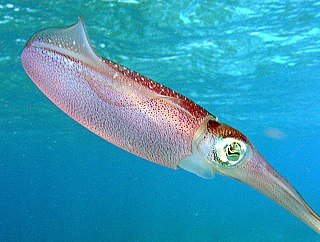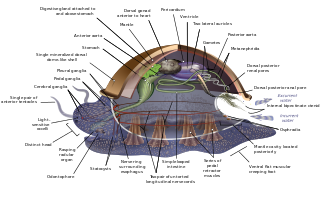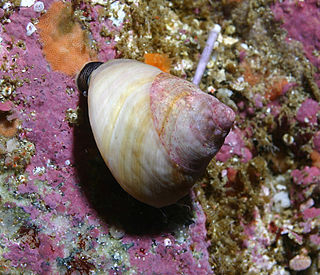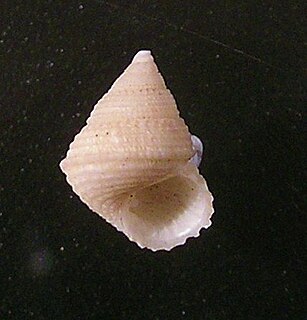
The gastropods, more commonly known as snails and slugs, belong to a large taxonomic class of invertebrates within the phylum Mollusca, called Gastropoda. This class comprises snails and slugs from saltwater, from freshwater, and from the land. There are many thousands of species of sea snails and slugs, as well as freshwater snails, freshwater limpets, and land snails and slugs.

Heterobranchia, the heterobranchs, is a taxonomic clade of snails and slugs, which includes marine, aquatic and terrestrial gastropod mollusks.

Lophotrochozoa is a clade of protostome animals within the Spiralia. The taxon was established as a monophyletic group based on molecular evidence.

Caenogastropoda is a taxonomic clade, a large diverse group which are mostly sea snails and other marine gastropod mollusks, but also includes some freshwater snails and some land snails.

The evolution of the molluscs is the way in which the Mollusca, one of the largest groups of invertebrate animals, evolved. This phylum includes gastropods, bivalves, scaphopods, cephalopods, and several other groups. The fossil record of mollusks is relatively complete, and they are well represented in most fossil-bearing marine strata. Very early organisms which have dubiously been compared to molluscs include Kimberella and Odontogriphus.

The Solenogastres, common name the solenogasters, are one subclass of small, worm-like, shell-less molluscs (Aplacophora), the other subclass being the Caudofoveata (Chaetodermomorpha).

Trochoidea is a superfamily of small to very large vetigastropod sea snails with gills and an operculum. Species within this superfamily have nacre as the inner shell layer. The families within this superfamily include the Trochidae, the top snails. This superfamily is the largest vetigastropodan superfamily, containing more than 2,000 species.

Naticidae, common name moon snails or necklace shells, is a family of minute to large-sized predatory sea snails, marine gastropod molluscs in the clade Littorinimorpha. The shells of the species in this family are mostly globular in shape.

Helcionelloida is an extinct group of ancient molluscs. These are the oldest known conchiferan molluscs, that is, they had a mineralised shell. Some members of this class were mistaken for Monoplacophorans. The class was erected by Peel in 1991.
Solariellidae is a family of small sea snails, marine gastropod mollusks in the superfamily Trochoidea.

Mollusca is the second-largest phylum of invertebrate animals after the Arthropoda. The members are known as molluscs or mollusks. Around 85,000 extant species of molluscs are recognized. The number of fossil species is estimated between 60,000 and 100,000 additional species. The proportion of undescribed species is very high. Many taxa remain poorly studied.
Knightoconus antarcticus is an extinct species of fossil monoplacophoran from the Cambrian Minaret Formation of Antarctica. It is thought to represent an ancestor to the cephalopods. It had a chambered conical shell, but lacked a siphuncle.

Euthyneura is a taxonomic clade of snails and slugs, which includes species from freshwater, marine, aquatic and terrestrial gastropod mollusks in the clade Heterobranchia.
Winston F. Ponder is a noted malacologist from New Zealand who has named and described many marine and freshwater animals, especially micromolluscs. He graduated with an MSc, PhD and DSc from the University of Auckland, New Zealand.

Seguenzioidea is a superfamily of minute to medium-sized sea snails, marine gastropod mollusks in the clade Vetigastropoda.

Costellariidae sometimes called the "ribbed miters" is a taxonomic family of minute to medium-sized predatory sea snails, marine gastropod mollusks. This family of snails is also sometimes referred to as Vexillum miters. The main family of miter shells however is Mitridae, a closely related group.

Yochelcionelloidea is an extinct superfamily of paleozoic molluscs of uncertain position. The earliest yochelcionellids are known from the Middle Tommotian, but they are most diverse from the Botomian through the early Middle Cambrian.
Anabarella is a species of bilaterally-flattened monoplacophoran mollusc, with a morphological similarity to the rostroconchs. Its shell preserves evidence of three mineralogical textures on its outer surface: it is polygonal near the crest of the shell, subsequently changing to both spiny and stepwise. Its internal microstructure is calcitic and semi-nacreous. Its name reflects its provenance from Anabar, Siberia. It has been interpreted as ancestral to the rostroconchs, and has been aligned to the Helcionellidae.
Protowenella is a genus of helcionellid from the Middle Cambrian of Australia. It has a strongly spiralled, smooth shell with concentric ridges that have low relief. Other than its tighter coiling, it is very similar to Tichkaella.
Trochida is an order of small to very large vetigastropod, Recent and extinct sea snails with gills and an operculum.











